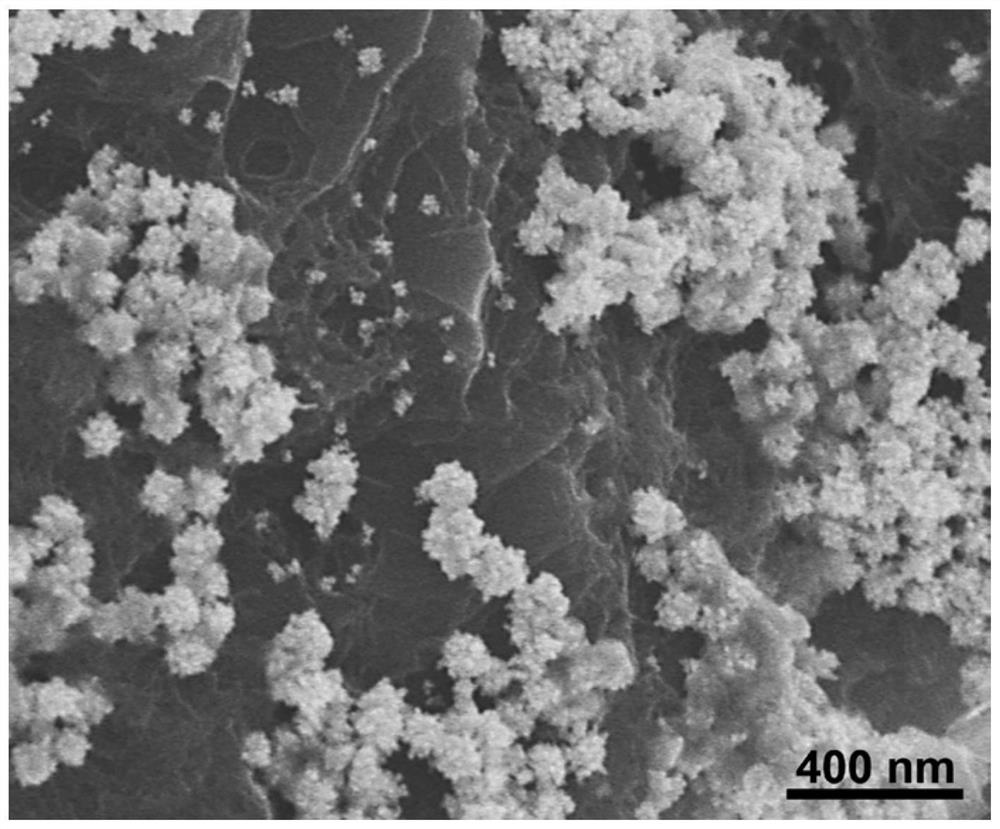Preparation method and application of red phosphorus/gold nanoflower composite material
A technology for gold nanoflowers and composite materials, which is applied in the field of preparation of red phosphorus/gold nanoflower composite materials to achieve the effects of enhancing Raman signals, sensitive detection results, and reducing Raman detection limits
- Summary
- Abstract
- Description
- Claims
- Application Information
AI Technical Summary
Problems solved by technology
Method used
Image
Examples
Embodiment 1
[0028] A preparation method of red phosphorus / gold nanoflower composite material, comprising the following steps:
[0029] (1) Preparation of nano-red phosphorus by hydrothermal method
[0030] Red phosphorus was added to deionized water to make a red phosphorus solution with a concentration of 1 / 60 g / ml, which was then transferred to a Teflon-lined stainless steel autoclave and heated to 200 °C for 12 hours. Carry out centrifugation, wash the red precipitate obtained by centrifugation with deionized water and ethanol several times, and continue drying at 60°C for 12 hours to obtain nano-red phosphorus;
[0031] (2) Preparation of red phosphorus / gold nanoparticles by in situ deposition method
[0032] Add the nano-red phosphorus prepared in step (1) into deionized water, stir and ultrasonically peel off for 10 hours to obtain a nano-red phosphorus solution with a concentration of 1 g / L; at the same time, disperse chloroauric acid in deionized water to obtain a concentration o...
Embodiment 2
[0041] A preparation method of red phosphorus / gold nanoflower composite material, comprising the following steps:
[0042] (1) Preparation of nano-red phosphorus by hydrothermal method
[0043] Red phosphorus was added to deionized water to make a red phosphorus solution with a concentration of 1 / 60 g / ml, which was then transferred to a Teflon-lined stainless steel autoclave and heated to 200 °C for 12 hours. Carry out centrifugation, wash the red precipitate obtained by centrifugation with deionized water and ethanol several times, and continue drying at 60°C for 12 hours to obtain nano-red phosphorus;
[0044] (2) Preparation of red phosphorus / gold nanoparticles by in situ deposition method
[0045] Add the nano-red phosphorus prepared in step (1) into deionized water, stir and ultrasonically peel off for 10 hours to obtain a nano-red phosphorus solution with a concentration of 1 g / L; at the same time, disperse chloroauric acid in deionized water to obtain a concentration o...
Embodiment 3
[0051] A preparation method of red phosphorus / gold nanoflower composite material, comprising the following steps:
[0052] (1) Preparation of nano-red phosphorus by hydrothermal method
[0053] Red phosphorus was added to deionized water to make a red phosphorus solution with a concentration of 1 / 60 g / ml, which was then transferred to a Teflon-lined stainless steel autoclave and heated to 200 °C for 12 hours. Carry out centrifugation, wash the red precipitate obtained by centrifugation with deionized water and ethanol several times, and continue drying at 60°C for 12 hours to obtain nano-red phosphorus;
[0054] (2) Preparation of red phosphorus / gold nanoparticles by in situ deposition method
[0055] Add the nano-red phosphorus prepared in step (1) into deionized water, stir and ultrasonically peel off for 10 hours to obtain a nano-red phosphorus solution with a concentration of 1 g / L; at the same time, disperse chloroauric acid in deionized water to obtain a concentration o...
PUM
 Login to View More
Login to View More Abstract
Description
Claims
Application Information
 Login to View More
Login to View More - R&D
- Intellectual Property
- Life Sciences
- Materials
- Tech Scout
- Unparalleled Data Quality
- Higher Quality Content
- 60% Fewer Hallucinations
Browse by: Latest US Patents, China's latest patents, Technical Efficacy Thesaurus, Application Domain, Technology Topic, Popular Technical Reports.
© 2025 PatSnap. All rights reserved.Legal|Privacy policy|Modern Slavery Act Transparency Statement|Sitemap|About US| Contact US: help@patsnap.com



